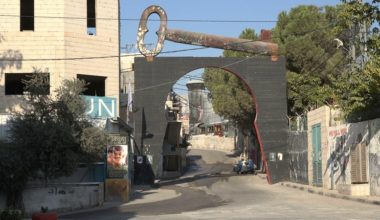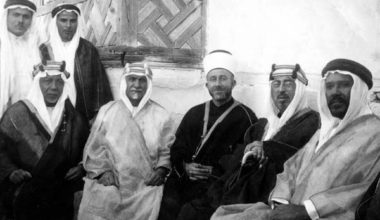
By Polly Withers, CBRL Fellow at the Kenyon Institute.
This post is an overview of a monograph that Polly is currently working on that looks at the “alternative” Palestinian music scene in post-Oslo Palestine.
“I don’t care where you’re from; where you at?” forms the chorus to the electro-dabka band 47Soul’s 2015 single “Don’t Care Where You From”. Comprised of four young Palestinian men, their words stress outlook – rather than location – is what matters when forming personal and collective identities. Mapping subjectivities beyond the nation, their lyrics galvanise a style and music-based scene currently proliferating among Palestinian youth. Spread across the Levant, and sometimes showcased internationally, this self-titled “alternative” community defies rigid categorisation. Those networked to it fuse local Arabic music repertoires, with global electronic, reggae, and hip-hop beats, to produce a ‘new’ translocal musical genre.
Research on Palestinian popular music, however, normally presents Palestinian music through two frames: as folkloric identity, or as national resistance. This literature often focuses on hip-hop cultures, despite the fact that musicians make many different types of music (e.g. glitch, techno, trip-hop, reggae, psy-trance, shamstep, electro-dabke). Moreover, in these works, Palestinian rap tends to be presented as a tool the younger generations use to resist Israeli occupation, and/or build collective, national identities. My research offers a different interpretation of Palestinian popular music that critiques these traditional straightjackets. Moving beyond dominant representations of Palestinian art, it considers when music may not only be about national protest, or resistance identities.
The research stems from two years of qualitative fieldwork (2012, 2014, 2017-2018) in four different cities that house large Palestinian communities: East Jerusalem (the Palestinian capital in the Occupied Palestinian Territory), Ramallah (the West Bank/Occupied Palestinian Territory), Amman (the capital of Jordan and home to many Palestinian refugees), and Haifa (a city in modern-day Israel with a large Palestinian population). Focused on the contemporary moment, it draws on 100 interviews with young musicians, DJs, and their fans, and 200 participant observations at the concerts, parties, raves, and bars they frequent. Through this material, I explore how and in what way young people negotiate ‘everyday’ social and political power structures through music.
My findings show that this music looks different when considered in distinct contexts. On a local level, many young adults in Palestine are fed up. The 1993 Oslo Peace Process has not delivered peace, and trust in the national leadership is at an all-time low. In this context, many youth employ their music to express frustration with the Palestinian Authority’s perceived hollowing out of the Palestinian national movement for liberation. Because the PA utilises classical symbols of Palestinian national identity (the kuffiyeh, for example, or the olive tree) to bolster their state-building programme, many young adults argue that such markers have lost their meaning. They are thus reluctant to hang their art solely on such scaffolds. Instead of deploying their work to convey orthodox nationalist sentiments, they use it to point to fractures in top-down nationalisms. Rejecting the local, regional, and international elite’s two-state solution in particular, they narrate their collective belongings outside the 1967 borders on the lines of Bilad Al-Sham (Greater Syria, which spans across Palestine, Jordan, Syria, and Lebanon). They thus form political subjectivities outside of established political frameworks.
However, while political content is foreground, it is not the only issue with which youth are concerned. Unenthusiastic about having their music appreciated purely because it is Palestinian – rather than because it sounds good – many emphasise that they are musicians who “happen to be” Palestinian (i/v, Riziq, Ramallah 23/10/2012), and not only Palestinian musicians. They thus affirm aesthetic identities alongside place-based ones. Indeed, music, they claim, is a source of fun; they use it to flout various generational and gendered orders (e.g. holding music parties where alcohol, drugs, flirting, and dancing takes place, and queer subjectivities proliferate).
Since many of these identities are formed through young adult’s consumption practices, they are also both product and producer of post-Oslo capitalist shifts in Palestine, which increased middle class time and money for leisure. Participation in the scene requires members have the financial means to buy certain items – musical instruments or electronic software, for example, as well as entrance tickets to clubs, drinks in bars, and certain fashion items. While culturally marginal vis-à-vis wider Palestinian society, access to the scene remains exclusive. In this cultural space, young people thus trouble gendered and sexual normativities, while reinforcing class-based power relations.

Interestingly, analysing Palestinian performances in non-local spaces reveals a different picture. When musicians perform in London, they are “branded” in particular ways. Their self-representations, or the representations their international hosts circulate of them, privilege identities distanced from locally. I argue that this happens in two ways: on the one hand, ‘world’ music events present musicians as ‘exotic others’, while on the other, solidarity networks confine them to national-resistance frameworks. By tracing these dynamics, I explore intersections between ‘race’ discourse, capitalism, and music labelled ‘political’/‘world’ as it travels.
The project thus makes two arguments. First, it suggests that through music, scene members perform unconventional identites beyond dominant national, gendered, and poltical norms. Second, since geopolitical power often shapes the way Palestinian music travels, we need not only ask what such music conveys, but rather, why are we presented with particular renderings of Palestinian art? Critically positioning cultural production in the transnational contexts that inform, and are informed by, such aesthetic practices, this study situates Palestinian music beyond narrow national perspectives, to ask instead what its circulation reveals about translocal power structures.
Polly Withers is a postdoctoral research fellow with CBRL at the Kenyon Institute in East Jerusalem. Her interdisciplinary, ethnographic, and gender-sensitive research explores everyday politics in Palestinian performative and expressive music practices. She holds an ESRC-funded PhD in Middle East Politics from the University of Exeter (2017). Currently, she is working on a monograph about the “alternative” Palestinian music scene in post-Oslo Palestine. This book is based on her PhD thesis, for which she was awarded the 2018 Leigh Douglas Memorial Prize for the best PhD dissertation on a Middle Eastern topic in the humanities and social sciences. Following her post with the CBRL, she will begin an ESRC postdoctoral fellowship at the London School of Economics, in the UK.
The views expressed by our authors on the CBRL blog are not necessarily endorsed by CBRL, but are commended as contributing to public debate.















